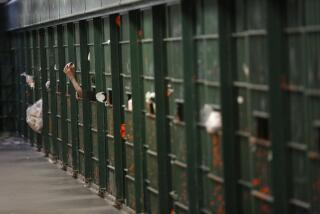Race walls won’t end jail riots
For years, Sheriff Lee Baca has known that the L.A. County jails are a powder keg. Overcrowding and understaffing, and the increased tension that those two factors bring, have created a situation potentially so volatile that everyone inside -- inmates and deputies alike -- is unsafe. Last week, dilapidated, outmoded facilities provided the fire that ignited the fuse.
Despite what you may be hearing, race is not the issue. Sure, racial tensions carry over from the streets and into the jails. If a major fight breaks out, street gang and all other affiliations are pushed aside and inmates join with others of the same race. If they don’t, they can expect to be targeted and attacked by members of the group they abandoned.
But segregating inmates by race doesn’t solve the problem. It does nothing to identify the problem inmates who create the violence and mastermind riots in the jails. Those high-risk inmates feed off the racial tension and magnify it.
Segregating inmates by race may work as a short-term measure to protect the safety of inmates and deputies in an emergency situation, but it will never solve the underlying problems in L.A. County’s jails.
I am in the jails almost every day. I can tell you what inmates fight about, and it’s not about skin color. They fight about who should get the bottom bunk, who should retrieve their food first, who uses the phone and who controls the dispensing of toilet paper.
Yes, race has become a visible and unavoidable part of the power structure in the jails. But only when tension is allowed to peak -- as it has now -- does chaos follow.
Last week, for instance, when half-century-old plumbing broke at the East Facility at Pitchess Detention Center in Castaic, sheriff’s deputies rushed to move 1,200 inmates to neighboring facilities. As a result, there were 500 extra inmates at the North County Correctional Facility on Saturday when the first wave of violence broke out. Tension was at an all-time high. Deputies were greatly outnumbered. Even before the violence began, inmates had warned of the possibility of riots and had begged authorities for help.
Instead, the situation was allowed to deteriorate, and riots broke out over several days. The violence involved as many as 2,000 inmates, who threw bunk beds over balconies and fought one another with fists and whatever weapons they could find. One inmate died and nearly 90 were injured.
The situation did not have to escalate to this level. The Sheriff’s Department’s budget has almost doubled from $1.1 billion to $1.9 billion -- and the budget for jails has grown about 75% -- in the last 10 years. But with facilities literally falling apart and high-risk, sometimes violent inmates packed into cells designed for far fewer and far less dangerous inmates, the sheriff has been unable to recruit new staff for jobs that have little to offer besides long hours and grueling conditions.
One important first step to make the jails safer for inmates and workers alike is to separate inmates not by race but by their proclivity toward violence. Baca said last week that he hoped to do just that next month, using the Twin Towers Correctional Facility in downtown L.A. to house “level eight and nine” inmates -- the most violent in the system.
But Baca must take several other steps as well. He must reduce overcrowding and improve conditions in the existing jails, and he must find a way to increase staff. Baca is planning on an increase in the overall jail population (because he intends to release fewer inmates early) -- yet it’s clear that he can’t control the situation at its current level.
In 2005, the U.S. Supreme Court ruled in a 5-3 decision that former inmate Garrison Johnson was right. Johnson, who is African American, had filed suit after being repeatedly segregated in California’s detention facilities. The high court’s decision recognized that housing inmates by race is a Band-Aid solution. In fact, the court said, racial segregation can make enemies out of people who might otherwise get along.
The proof that violence can be avoided without segregating inmates by race is in two small programs run within the 21,000-inmate L.A. County system. Inmates housed at the Century Regional Detention Facility in Lynwood are enrolled in focused programs designed to give war veterans, drug offenders and domestic abuse offenders skills they can use when released, and the privilege of those classes provides a reason not to fight. Inmates are not divided along racial lines, but the most violent have been weeded out and are held elsewhere. The result: Racial violence is not a problem among these inmates. Gay men of different races who are gang members, and even some who are suspected of murder, are housed together in a specialized unit at the Men’s Central Jail.
These inmates are given the opportunity to take GED classes, drug education classes and anger management classes. Tension in these units is lower, violent outbreaks are rare and recidivism rates consistently decline.
The recent violence proves that the Sheriff’s Department cannot manage the current jail population and certainly should not increase the inmate population.
But Baca hopes to do just that at the end of March, when additional beds at the Century Regional Detention Facility open. If things are kept as they are, more violence is assured.
Instead, the Sheriff’s Department should focus its resources on better securing the inmates in custody and expanding programs to inmates of all security levels to reduce tension in the jails, improve public safety and create an environment in which Baca can maintain appropriate staffing levels.
More to Read
Sign up for Essential California
The most important California stories and recommendations in your inbox every morning.
You may occasionally receive promotional content from the Los Angeles Times.










